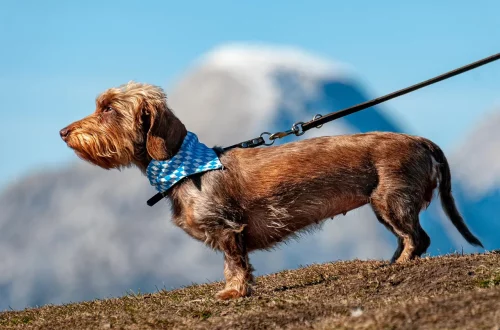
Understanding Schnauzer Tail: Care, Grooming, and Health Tips
Understanding the nuances of a Schnauzer’s tail is essential for any owner or enthusiast of this charming breed. The tail of a Schnauzer, whether it’s a Standard, Miniature, or Giant variety, serves not just as a physical extension of the dog but also as a key indicator of its emotional state and overall well-being. Schnauzers are known for their distinctive appearance, with their wiry coats and expressive faces, but their tails can also tell a unique story.
A Schnauzer’s tail can be a subject of fascination, as it often reflects the dog’s mood, energy level, and even its health. Proper understanding and care of this feature can enhance the overall bond between the dog and its owner. Whether your Schnauzer has a docked or natural tail, it’s vital to recognize the importance of maintaining this part of its anatomy. Just like other aspects of grooming and health care, the tail requires attention and care to ensure that your pet remains happy and healthy.
In this article, we will explore various aspects of Schnauzer tails, including their grooming needs, health considerations, and care tips that every owner should know. By gaining a deeper understanding of these factors, you can ensure your Schnauzer enjoys a joyful and healthy life.
The Importance of Tail Grooming for Schnauzers
Grooming a Schnauzer goes beyond simply brushing its coat; it extends to taking care of its tail as well. A well-groomed tail not only looks appealing but also plays a crucial role in your dog’s overall hygiene and comfort. Regular grooming sessions should include inspecting the tail for any signs of irritation or injury, particularly at the base where it connects to the body.
The tail can accumulate debris, dirt, and even matting, especially in Schnauzers with longer fur. Therefore, it’s essential to use the right tools for grooming. A slicker brush is typically effective for removing tangles and loose hair. Additionally, it’s a good idea to bathe your Schnauzer regularly — but be cautious not to wash too frequently, as this can strip the natural oils from their coat and skin. When washing your dog, ensure that you thoroughly rinse the tail area to remove any soap residue.
Another important aspect of tail grooming is trimming. Depending on your Schnauzer’s coat type, regular trimming may be necessary to keep the tail looking neat and tidy. It’s advisable to consult with a professional groomer if you are unsure about how much to trim. They can offer valuable advice based on your dog’s specific needs.
In addition to grooming, monitoring the tail for any signs of health issues is crucial. Look for any unusual lumps, bumps, or changes in the skin. A healthy tail should be free of redness, swelling, or discharge. If you notice anything concerning, don’t hesitate to contact your veterinarian for guidance.
Overall, regular grooming of the Schnauzer’s tail contributes to their hygiene and overall happiness. A clean, well-maintained tail helps your dog feel good, which in turn enhances their behavior and social interactions.
Health Considerations Related to Schnauzer Tails
Understanding the health aspects related to your Schnauzer’s tail is vital for any responsible pet owner. While Schnauzers are generally healthy dogs, they can be susceptible to certain conditions that may affect their tails and overall well-being. Health issues can arise due to various factors including genetics, diet, and lifestyle.
One common issue is tail injuries. Schnauzers, like many active breeds, can be prone to accidents that may cause pain or injury to their tails. This can include anything from getting their tail caught in a door to rough play with other dogs. It is crucial to monitor your Schnauzer’s behavior and ensure they are in a safe environment to minimize these risks.
Moreover, skin conditions can affect the tail area. Schnauzers can experience allergies, hot spots, or infections that may manifest as itching, redness, or swelling around the tail. Food allergies are particularly common in Schnauzers, so it’s essential to pay attention to any dietary changes or new treats that may trigger adverse reactions. Regularly checking your Schnauzer’s tail and surrounding area for any signs of discomfort can help catch issues early.
Another health concern relates to tail docking, which is a practice that some Schnauzer owners choose. Docked tails can sometimes lead to complications if not done correctly. If you have a Schnauzer with a docked tail, it’s important to ensure that the area is kept clean and free from irritation.
If your Schnauzer exhibits any unusual behavior, such as excessive licking of the tail or reluctance to wag it, these may be signs of discomfort or health concerns. In such cases, it’s crucial to consult a veterinarian for a thorough examination.
Remember, while this information is beneficial, it does not substitute professional medical advice. Always seek the guidance of a qualified veterinarian for any health-related issues concerning your Schnauzer.
Recognizing Emotional Signals Through a Schnauzer’s Tail
The tail of a Schnauzer is not merely an aesthetic feature; it is also a powerful tool for communication. Understanding the various ways your Schnauzer expresses itself through its tail can greatly enhance your relationship with your pet. A dog’s tail position and movement can provide vital clues about its emotional state.
When a Schnauzer’s tail is held high and wagging energetically, it usually indicates happiness and excitement. This is often seen during playtime or when they are greeting their owners. Conversely, a low or tucked tail can indicate fear, anxiety, or submission. If you notice your Schnauzer displaying a tucked tail, it may be beneficial to assess the situation to determine if they are feeling insecure or threatened.
A slow wagging tail can signal uncertainty or hesitation. In contrast, a fast, vigorous wag might mean that your Schnauzer is eager to engage in play or receive affection. Understanding these signals can help you respond appropriately to your Schnauzer’s needs and emotions.
Tail communication is especially important in social interactions with other dogs. A confident Schnauzer will often approach other dogs with a high, wagging tail, while a more timid dog may approach with a lower tail position. Observing these behaviors can help you gauge your Schnauzer’s comfort level in various situations and assist in managing their social experiences.
In addition to tail movements, the overall condition of your Schnauzer’s tail can also reflect its emotional health. A well-groomed and healthy tail is often a sign of a happy and well-cared-for dog. If your Schnauzer’s tail appears unkempt or shows signs of distress, it may be an indicator that they are experiencing stress or discomfort in their environment.
By learning to read your Schnauzer’s tail signals, you can foster a deeper bond and ensure that your dog feels loved and secure. Tail communication is a fascinating aspect of dog behavior, and being attuned to these signals can significantly improve your relationship with your furry friend.
In conclusion, taking care of your Schnauzer’s tail goes beyond aesthetics; it encompasses grooming, health considerations, and understanding emotional signals. By paying attention to this often-overlooked aspect of dog care, you can ensure that your Schnauzer leads a happy, healthy life.
**Disclaimer:** This article is for informational purposes only and is not intended as a substitute for professional veterinary advice. Always consult your veterinarian for any health concerns regarding your pet.




